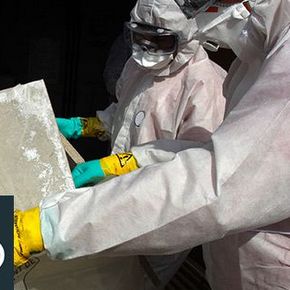
Is asbestos still a risk in the UK?
 GUEST BLOG: Liz Burton, an author for High Speed Training, outlines the dangers of asbestos in existing buildings, the risks that persist in the workplace and the impact on health.
GUEST BLOG: Liz Burton, an author for High Speed Training, outlines the dangers of asbestos in existing buildings, the risks that persist in the workplace and the impact on health.
The problem with asbestos is that, because it was used so extensively during the 1950s-1980s for its useful properties – heat-resistance, incombustibility, and cheapness just to name a few – it still exists in many buildings, particularly those built before the year 2000.
Although the manufacture and use of asbestos was banned in November 1999, we’re still to this very day ridding existing buildings of asbestos and trying to raise awareness about its dangers. And this is akin to the nature of asbestos: the symptoms and reactions take a long time to develop and leave the afflicted with long-term, long-lasting ill-effects.
Some people are only just now experiencing the aftermath of being exposed to asbestos. That includes those who were exposed over two decades ago and those who may be exposed on a daily basis, such as individuals who work with buildings.
Many people don’t know what asbestos is, let alone the dangers it poses or where it might be present. Coupled with the fact that it can take between 15 to 60 years for ill-effects to develop after exposure, this makes asbestos a very real and very dangerous risk.
Each new generation needs to be educated about it if we’re to completely eliminate the risk it poses decade after decade.
Why is asbestos dangerous?
Asbestos fibres are extremely harmful when inhaled. One isolated instance of exposure is unlikely to cause much harm, but regular, excessive, and/or prolonged exposure can lead to lung cancer and mesothelioma (a type of cancer particularly associated with asbestos).
When asbestos-containing materials are disturbed, e.g. during activities like drilling holes into walls, removing plasterboards, or knocking down walls, fibres are released into the air. If they are left alone, however, fibres are not released and so no harm is posed.
Where might asbestos be present?
Asbestos can be found in numerous parts of a building’s internal or external structure. This includes:
- Asbestos insulating board in walls, ceilings, and doors.
- Lagging on boilers and pipes.
- Textured wall and ceiling coatings.
- Loose fill insulation.
- Floor tiles.
- Fire blankets and fire doors.
- Bath panels.
- Cement roofs.
- Toilet seats and cisterns.
- Roof felt.
- Garage roofs.
Houses built within the past decade are unlikely to have asbestos-containing constructions. However, in houses built or refurbished between 1950 and 1980, it’s very likely that asbestos will be present somewhere.
Who might be affected by asbestos?
As mentioned earlier, people who work with buildings are particularly at risk; they are most likely to disturb asbestos during work activities. But everyone should be alert to the possibility of asbestos being present in their home or place of work.
People at particular risk include:
- Maintenance staff.
- Plumbers and gas fitters.
- Plasterers, painters, and decorators.
- Construction and demolition workers.
- Heating and ventilation engineers.
What should I do if I discover/suspect asbestos?
First of all, leave it alone. If you ever come across a material you’re not familiar with or unsure about, assume it contains asbestos. Do not disturb it or attempt to remove it yourself.
You should inform your local authority and arrangements should be made for the asbestos to be tested or – depending on its condition – removed by a licensed asbestos removal company.
If the asbestos is undisturbed and in good condition, it can be left alone. But it must be labelled and a note of its location must be made, which can be referred to by anyone who needs to work on the building for whatever reason at a later date, so to avoid disturbing it or to make sure it’s removed safely.
………………….
Liz Burton is a content author for High Speed Training, an online training provider that offers a wide range of health and safety eLearning courses, including Asbestos Awareness (Category A).
Latest news

26th July 2024
Enfield Speciality Doors completes world-class project for Atlas Copco HQ
A rundown office and warehouse building completely transformed into a modern headquarters for Atlas Copco has been fitted with more than 120 internal fire doors from Enfield Speciality Doors.
Posted in Access Control & Door Entry Systems, Articles, Building Industry News, Building Products & Structures, Building Systems, Case Studies, Doors, Interior Design & Construction, Interiors, Posts, Restoration & Refurbishment, Retrofit & Renovation, Security and Fire Protection, Sustainability & Energy Efficiency, Timber Buildings and Timber Products, Wooden products
26th July 2024
Abloy UK launches new white paper
Abloy UK, a leading provider of security and access control solutions, has launched a new white paper.
Posted in Access Control & Door Entry Systems, Architectural Ironmongery, Articles, Building Industry News, Building Products & Structures, Building Services, Doors, Facility Management & Building Services, Health & Safety, Information Technology, Innovations & New Products, Publications, Research & Materials Testing, Security and Fire Protection
26th July 2024
MCRMA Member Profile: David Roy, Director of Roofconsult
David Roy of MCRMA member company Roofconsult has more than 50 years’ experience to draw upon working in the building envelope sector and a unique perspective on how it has changed in that time.
Posted in Articles, BIM, Infrastructure & CAD Software, Building Associations & Institutes, Building Industry News, Building Products & Structures, Building Services, Building Systems, Cladding, Information Technology, Restoration & Refurbishment, Retrofit & Renovation, Roofs, Walls
26th July 2024
Strand: Enhancing Door Functionality and Safety
Craig Fox, Sales Director for Strand Hardware, outlines how door industry professionals might apply door limiting stays…
Posted in Architectural Ironmongery, Articles, Building Industry News, Building Products & Structures, Building Services, Doors, Facility Management & Building Services, Health & Safety, Restoration & Refurbishment, Retrofit & Renovation
 Sign up:
Sign up: